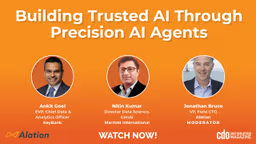Opinion & Analysis
7 Must-do Steps to Build a Data-Driven Culture and Power Digital Transformation
Written by: Christine Andrukonis, Founder | Notion Consulting
Updated 4:26 AM UTC, Mon July 10, 2023

Your company’s data is one of your most valuable assets.
Yet, while many companies embrace significant digital transformation efforts – setting up analytics functions and acquiring huge volumes of data – they struggle to leverage their assets for driving strategic business outcomes. That said, those who master these efforts will have a decided advantage over their competitors.
As a strategic asset, data can help your organization with faster and smarter decision-making that can contribute to targeted revenue generation, product development, operational efficiencies, and improved customer or employee experiences. However, it requires a culture shift.
Undeniably, organizations have blind spots that hold back their leadership from making the most of their data. Below are some of the most common mistakes:
- Proceeding without a clear vision: Setting a ‘north star’ aligns stakeholders, builds awareness, and helps accelerate adoption of new practices.
- Thinking small: Putting data at the center of the business will require a shift in thinking, culture, and ways of working. It is not a check-the-box exercise.
- Putting technology before strategy: People need to adopt and use the new systems, which will change roles, skills, capabilities, ways of working, and the culture across the organization.
- Engaging stakeholders at the wrong level: Engagement must begin in the C-suite, with each leader acting as a data champion with and for their organization. Partners, advocates, decision-makers, and influencers will be critical.
- Being unclear about ownership: Is it IT, a new data-analytics group, or another component of the business? A lack of defined roles and responsibilities, combined with a strategically organized structure to manage them, could be problematic down the line.
While in the planning stages, leaders can address these potential blind spots by focusing on four essential areas:
- Strategy: A data strategy is a roadmap for using the data to help the organization reach its business goals. The roadmap defines the people, processes, and technology to solve your data challenges and support your vision. It should not exist in a vacuum, but rather align with your company’s business objectives and address the problems that data can help solve.
- Governance: Implement a data-governance program to ensure that data is safe, protected, trustworthy, and accessible to the people who need it. Make data attainable and accurate. If people don’t trust the data, you may lose them forever. Plan your data-governance program with respect to people (their roles and skills), process, and policy.
- Technology & Process: Select the right platform based on your data strategy. Turn data into insights with visualization tools to help users understand and utilize the information.
- People, Mindset & Culture: Determine where key roles and functions should be aligned. For example, should analysts be aligned to the business or IT? How will IT support the business in their analytics needs? Who ‘owns’ the process? Creating a culture of shared accountability across the user community will shift the mindset and drive new ways of working – which is critical for developing a data-literate workforce who can think about data in new ways. Culture change does not happen overnight; leaders will need to advocate for and ‘role-model’ the change they want to see.
Ready To Get Started?
In order to build a data-driven culture to help power your digital transformation and hone your competitive edge, follow these 7 crucial steps:
- Define your vision for change
- Identify a leader for this effort and empower them to lead
- Assess your organization’s data maturity and readiness. Determine what you can do now versus longer-term
- Identify your success measures to assess performance and mitigate risk.
- Evaluate if your organization has the right people and skills for the job; find and fill the gaps
- Develop a stakeholder-engagement strategy. Prioritize critical relationships to maximize outcomes
- Create a communications/engagement plan, including a slate of key messages
After you’ve established the basics, here are best practices for making sure your progress ‘sticks’:
- Equip leaders to drive the change by supplying them with toolkits, talking points, and information sessions
- Engage key stakeholders on an ongoing basis to evaluate progress, hear feedback, and course-correct
- Communicate frequently. Share progress, success stories, and case studies to demonstrate how the data is having a positive impact. It helps people see what’s possible
- Conduct ongoing learning opportunities through multiple channels (classroom, on-the-job, workshops, or office hours) to build employee skills and data literacy
- Set realistic expectations. Define what success looks like and be transparent about challenges along the way
- Create champions and functions to assist with driving adoption in their respective areas.
- Embed expectations in job descriptions and performance goals to hold people accountable
Creating a data-literate and data-driven organization takes commitment, but preparing for the future is well worth it to win the race against your competition.
About the Author
Christine Andrukonis is a Workplace Transformation Expert and founder of Notion Consulting, a change-management consultancy that helps leaders tackle their most complex business challenges. For over 20 years, she has been leveraging her unique combination of human resources and communications expertise to help C-suite executives lead change, activate their teams to shift strategy and structure, establish new business models and capabilities, enhance processes and technology, and strengthen talent and culture.
Part of the adjunct faculty at Cornell University, Andrukonis holds an MS from American University in organization development and change, as well as a BS in management from Penn State University.





